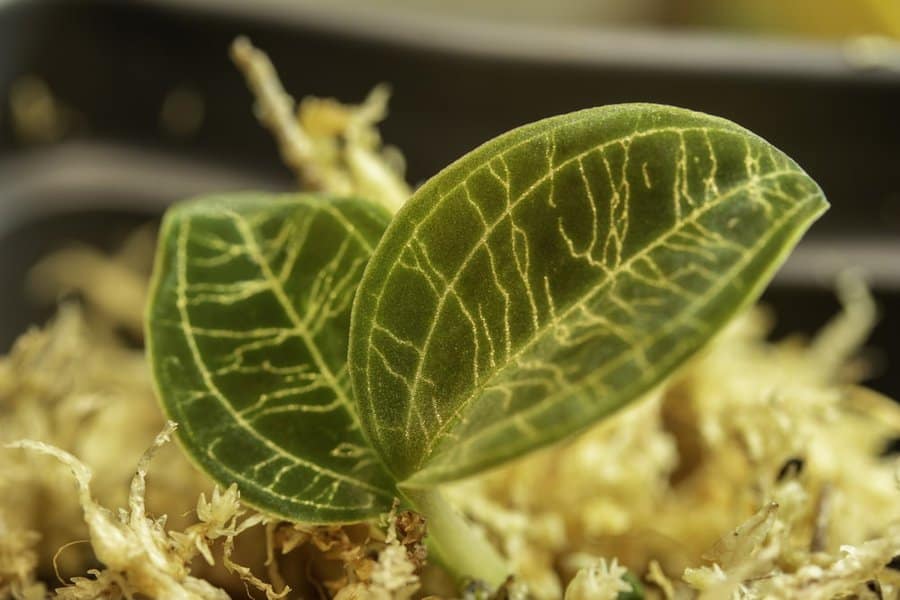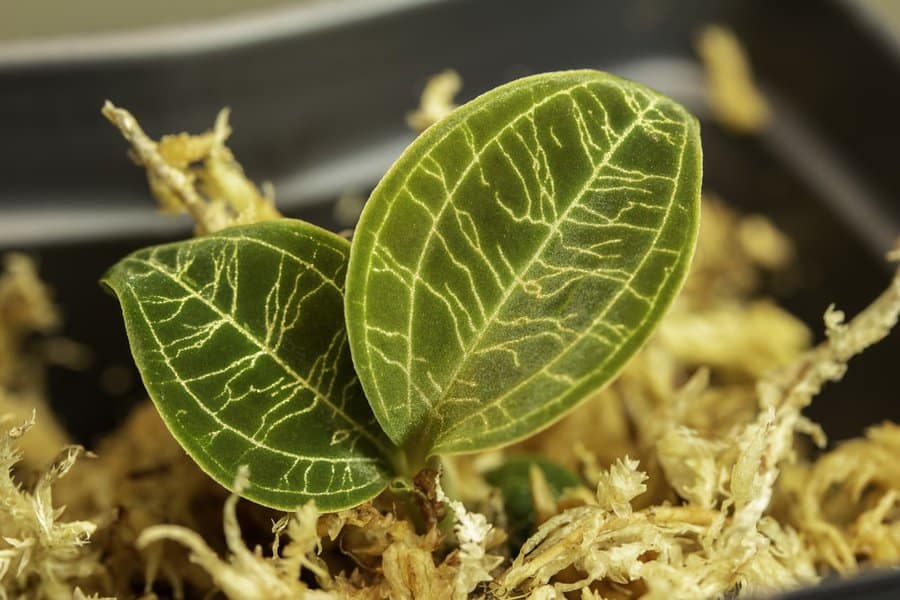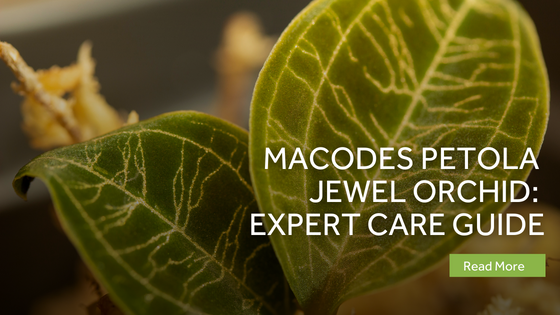Are you looking for a unique and vibrant houseplant to add to your collection? The Macodes petola, or jewel orchid, may be the one for you. Desired for its striking foliage resembling lightning, this plant is sure to impress. It is pickier than other plants, but read on to become an expert in no time!
Table of Contents
Macodes Petola Jewel Orchid Plant Overview
The Macodes petola belongs to the beautiful Orchidaceae family, home to many orchid species desired for their colorful flowers. However, this species in the Macodes genus is known for its shocking foliage. This species originates in southeast Asia, specifically in the Philippines, Malaysia, Borneo, and Sumatra.
Macodes petola plants are also known as jewel orchids, thanks to their vibrant, velvety leaves. The leaves stand out because of the contrasting colors and patterns. The main leaves are green, while the veins are golden and resemble lightning. Other prominent jewel orchid varieties in the Macodes genus include the Macodes iowii, Macodes dendrophilia, and Macodes sanderiana.
Jewel orchis types:
Macodes iowii: This jewel orchid has similar veining patterns, but the leaves are deep and dark purple.
Macodes dendrophilia: The dendrophilia species is different in color, with greyish-green leaves with silver veins.
Macodes sanderiana: This species of jewel orchid looks very similar to the Macodes petola Jewel Orchid but has thicker golden veins.
| Botanical Name | Macodes petola |
| Family | Orchidaceae |
| Genus | Macodes |
| Origin | Southeast Asia: Borneo, Sumatra, the Philippines, Malaysia |
| Sunlight | Light, well-draining, and well-aerated |
| Watering | Moderate |
| Soil | Light, well-draining, and well-aerated |
| Temperature | 65-85 degrees Fahrenheit |
| Propagation | Stem cuttings, rhizome division |
| Re-Potting | Every four years |
| Pests and Diseases | Bacterial or fungal disease, common houseplant pests, root rot |
| Toxicity | Non-toxic to humans and pets |

Macodes Petola Jewel Orchid Features
The Macodes petola plant is a species renowned for its beautiful foliage. The striking leaves grow to be around five inches wide, while the plant itself can grow to a height of around 10 inches.
This species produces flowers, but people often cut off the flower buds, so the plant does not grow to be lanky. The flowers themselves are white with centers of chocolate brown or light green and grow from a tall stem spike.
This species does not produce fruit from the flowers. Jewel orchids are non-toxic to humans and pets, making this a terrific houseplant variety.
Macodes Petola Jewel Orchid Care Guide
Caring for the Macodes petola jewel orchid plant can be challenging compared to other houseplants, but if you provide the proper care, your plant will thrive! These tropical species prefer warm temperatures, bright light, and moderate watering.
Jewel orchids grow well in large terracotta pots and prefer consistently moist soil and well-aerated for its root. Monthly fertilizer treatment can work wonders in supporting your plant growth. High humidity does wonders for this plant as well. Read on to learn more about Macodes petola care.
Ideal Growing Place
The Macodes petola Jewel Orchid can be successfully grown indoors and outdoors under the right conditions. If you are growing your plant outdoors, ensure your climate is suitable for this plant regarding lighting, temperature, and humidity.
Lightning bolt jewel orchid plants are also very popular as indoor house plants. They can thrive in terracotta pots with proper soil, lighting, humidity, temperature, and watering. This species will make your space sparkle with its beauty.
The growing season for the Macodes petola is during the warmer spring and summer months. During this time, the plant is growing new foliage. The Macodes petola typically flower when fall comes around, and growth slows down.
Water
Learning your Macodes petola plant’s watering schedule can take time and patience. These plants prefer to have high soil moisture without too much water remaining. Excess water held in the soil can lead to harmful root rot, so it is important to have well-draining soil.
A good way to determine when your plant needs water is to check the soil moisture levels often. For example, if you place two fingers into the upper soil layer and it feels dry, it is time to water. This test can help you understand how often your plant needs to be watered.
During the non-growing season of fall and winter, the plant will need to be watered less often.
Related Article: Best Garden Hose Reel: Water Your Garden
Sunlight
Bright indirect light is the best lighting for Macodes petola care. Exposure to too much direct sunlight can scorch the leaves of this species. A north-facing window is a great area to place your plant near, but keep it out of the direct sunlight. If your plant begins to grow and lean towards a light source, it is telling you it needs more light.
Temperature
The Macodes petola prefers to grow in warm temperatures between 65-85 degrees Fahrenheit. They grow best in the higher temperatures but can also safely manage 60-65 degrees Fahrenheit. So keep an eye on temperatures if growing your Macodes petola outdoors. If temperatures fall below 60 degrees, bring your plant indoors; otherwise, it will experience stress.
Soil
A loose, well-draining, and well-aerated soil mixture is best in Macodes petola care. Jewel orchids prefer soil that can retain water well without becoming too soggy. Some popular soil additives you can add to help the soil remain airy and retentive are pure sphagnum moss, perlite, peat moss, and coco coir.
A slightly acidic to neutral pH is best for the plant. Overall, it is important that your soil mixture allows proper air flow for roots to get oxygen but not hold too much water and cause root rot.
Humidity
Humidity levels in Macodes petola care fall in the range of 50-70%. Watering your plant properly helps plants get some moisture, but humidity in the air is also needed. Humidity trays and air humidifiers can help provide extra moisture but avoid misting. Misting extra moisture directly onto the leaves of this species can lead to bacterial or fungal disease of the plant.
Fertilizer
Giving some extra nutrients is needed for the Macodes petola. Giving your plant 1/4 strength liquid fertilizer about every four weeks in the growing season is recommended to support its health and growth. Since it is a slow grower, you do not need to provide more than this. This species does not require fertilizing during the fall and winter dormancy periods.
Pinching/Pruning
It may be time to prune your Macodes petola if you are noticing dead leaves, lanky or breaking stems, or if they have outgrown their space. To prune the leaves, take sterile tools like shears or a knife and cut the leaves at the stem base. Healthy leaves can be further used to propagate Macodes petola plants.
Potting and Re-potting
After bringing home a new Macodes petola plant, allow it to get used to your environment and acclimate to avoid shocking the plant during repotting. After some time, take your jewel orchid out of its original pot, and inspect the roots for any root rot or other damage. If you move the plant to a larger pot, only increase the new pot size by about one inch.
Place the plant into the new pot with fresh soil medium but do not pack soil, so the roots have air and oxygen available. Changing the amount of soil and pot size can change how much water the plant needs each time, so monitor soil moisture levels closely.
Common Pests, Toxins, Diseases & Other Problems
Macodes petola Jewel Orchid can be affected by common pests like aphids, spider mites, and mealy bugs. These tiny insects feed off your plant and steal important nutrients. Treat with neem oil and inspect your stems and leaves often.
Another common issue is bacterial and fungal leaf disease. When water keeps the leaves wet for too long, bacteria and fungi can dwell there and cause harm to the leaves with disease. Be sure not to mist your plant for this reason. Additionally, too much water in the soil can lead to harmful root rot, so follow the watering requirements carefully.
Jewel Orchid Propagation
Propagating jewel orchid plants can be done in various ways, the most common being stem cuttings and offset division. With the stem cutting method, locate an area of the stem that has one or more nodes and cut it to about three to four inches. Plant this cutting in fresh soil and watch for new root growth. Transfer to a new pot after a few weeks and care for it as normal.
You must locate an offset if you wish to propagate your Macodes petola using offset division. Offsets are short, lateral shoots coming from the mother plant’s base and are essentially genetic clones. Snip an offset off the mother plant, and plant it in new soil with fresh watering to promote new root growth.
Jewel Orchid Macodes Petola Mature Timeline
After propagating your Macodes petola through stem cutting or offset division, it will need time to sprout new root growth. It may take anywhere from four to eight weeks for adequate root growth. Once the roots are ready, place your propagated plant into a new pot with fresh soil and care for it like a mature Macodes petola Jewel Orchid.

Macodes Petola Care FAQ
Is Macodes Petola Jewel Orchid a Fast Grower?
Jewel orchids are not fast-growing and have a slower growth rate than most houseplants.
What Does Macodes Petola Jewel Orchid Smell Like?
The flowers of the Macodes petola have a smell that is similar to warm toast or hot hair tools.
How Long Does a Macodes Petola Jewel Orchid Bloom Last?
The blooms of jewel orchids can last around two to three weeks if the plant’s environment is mild in temperature.
Is Macodes Petola Jewel Orchid Rare?
The Macodes petola and other jewel orchids are considered a rare plant but are becoming more available through propagation methods.
How Can I Make Macodes Petola Bushier?
With the proper Macodes petola care, the plant will naturally grow compactly. If the plant grows in poor soil and has too much shade, it will grow in a skinny fashion. Pruning your plant can help keep a bushy shape.
Where to Find Macodes PetolaJewl Orchid For Sale?
Since Macodes petola is rarer, it may be hard to find instore. Look instead to online sites like Etsy, Amazon, or nursery websites that can ship these plants to you directly.
Should I Use a Mister for My Macodes Petola?
Misting your jewel orchids may not be the best idea due to this species’ susceptibility to bacterial and fungal foliage disease. These diseases are caused by water sitting on the leaves for too long.
Are Macodes Petola Toxic Plants?
Macodes petola is non-toxic to humans or pets.
Can You Grow Macodes Petola Under Artificial Light?
If your environment cannot provide enough natural light for your Macodes petola, fear not; this species can grow well with LED artificial light.
How Fast Does Macodes Petola Grow?
The jewel orchid can grow about three inches tall and six inches wide in a year.
How Big Does Macodes Petola Grow?
Jewel orchids like the Macodes petola can grow about 10 inches high.
The Bottom Line
The Macodes petola jewel orchid is a vibrant and foliage-rich plant that will spark interest in your space. This jewel orchid species is sure to impress because of its olive-green leaves and lightning-patterned golden veins. After reading through the Macodes petola care guide, you can now provide expert care to your plant!
Last Updated on August 26, 2022 by Gustaf Johansson




